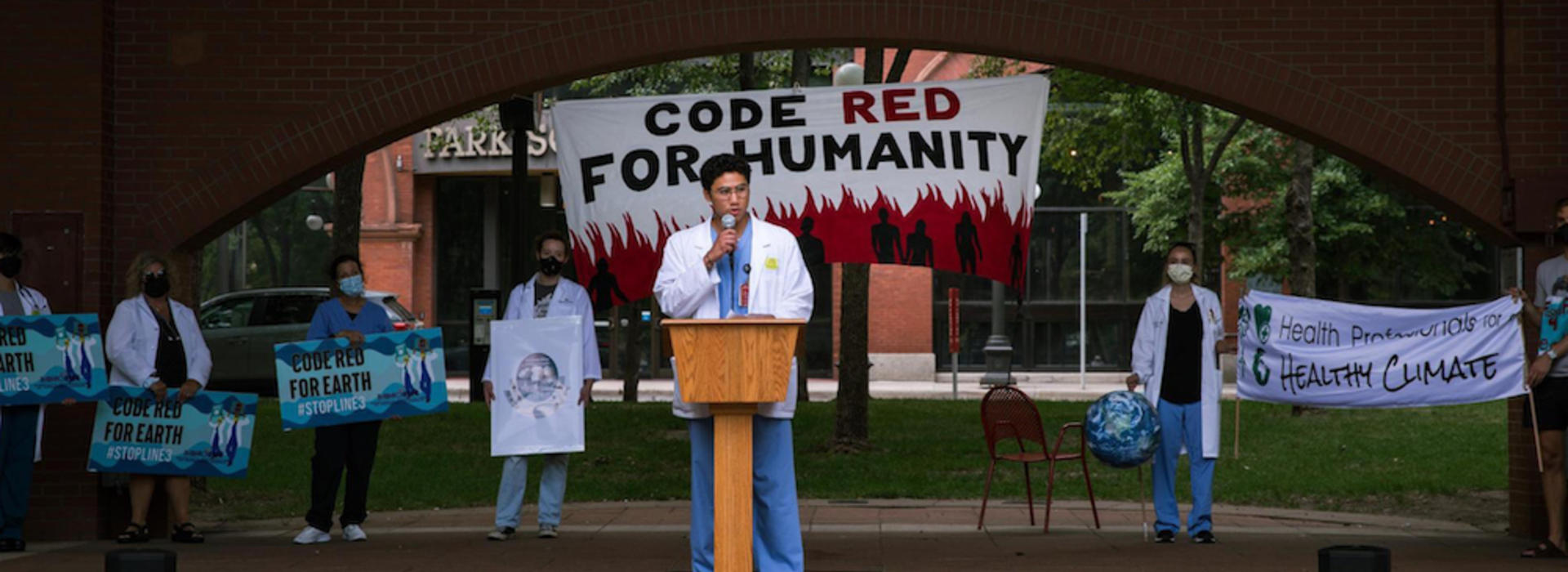
Health Students for a Healthy Climate Drive Renewed Emphasis on Planetary Health in Medicine
Global warming and cooling have been fairly routine throughout the history of the planet — with carbon dioxide playing a role in directing climate change. Whether carbon dioxide or natural factors are responsible for climate change occurring now, planetary and human health are deeply connected and physicians of the future are noticing.
“There are many ways that health and climate change intersect,” said Anna Rahrick, a third-year University of Minnesota Medical School student.
Rahrick’s interest in the relationship between climate and public health led her to Health Students for a Healthy Climate, an interdisciplinary student group aimed at helping health professionals learn about the impacts of climate change and ways to advance action as future health leaders. The student group is affiliated with Health Professionals for a Healthy Climate (HPHC), a nonprofit organization founded by a number of advocates affiliated with the University of Minnesota, including executive director Brenna Doheny, PhD, MPH, a postdoctoral associate at the Medical School’s Duluth Campus.
“The group hosts climate conversations where we pick a topic to explore,” Rahrick said. “It’s a great way for people to learn from one another since we come from different schools and backgrounds.”
The group is also involved in advocacy work, like calling attention to the health harms of the Line 3 pipeline, which is currently under construction in northern Minnesota, and working to influence public policy and opinion. Conor Nath, a third-year medical student and Health Students for a Healthy Climate member, worked with HPHC to co-author a paper highlighting the health impacts of Line 3.
“This is one way medical students and physicians can work with communities to contribute to our scientific expertise and health communications skills in our work towards climate justice,” Nath said.
Along with HPHC, Nath presented the paper’s findings to the Office of Governor Tim Walz as part of a teach-in to educate decision-makers about health harms of climate change. He also plans to publish on the topic.
“This is not just volunteer work,” Nath said. “This is one way we can advance medical literature and also work with communities to advance real-life change."
Planetary Health in Medical Education
With the guidance of Laalitha Surapaneni, MD, assistant professor in the Department of Medicine’s Division of General Internal Medicine, Rahrick and her peers participated in the Planetary Health Report Card project, a student-driven, metric-based ranking of environmental health education in medical schools. While the Medical School has multiple areas of opportunity, one focus is the integration of more robust environmental health topics in the curriculum.
“We’ve been talking about how to incorporate environmental and planetary health into the Medical School curriculum, a change students have been advocating for years,” Dr. Doheny said. “I think students understand how much they’re impacted by climate change already, and how this will absolutely be part of their work as a doctor.”
While Minnesotans might not think about the serious impacts of global warming given the cold winters, Minnesota is actually one of the fastest-warming states, and winters are warming faster than other seasons.
“Everyone is impacted by climate change differently, and it impacts underserved populations the most,” Rahrick said. “People who have the least power and are affecting climate change the least are the ones most affected by its consequences.”
Another aspect of the groups’ advocacy is supporting the Medical School, Duluth Campus’ mission to serve rural and Native communities who are vulnerable to the impacts of environmental degradation and changing climate due to their cultural and economic reliance on natural resources and agriculture. Threading environmental health throughout the curriculum is incredibly important for both campuses.
“I think we really need to live up to our mission of caring about Tribal health,” Dr. Doheny said. “These are things we need to understand and talk about institutionally, but we also need to speak to the larger community, showing that there is an evidence-based health impact on Tribal communities when their rights and needs are ignored.”
The student group is also hoping to do more community outreach, like webinars and opportunities for involvement, especially as the incidence of health conditions linked to climate change increase.
“As health professionals, if we know about these issues, we’re also going to know how it could be affecting our patients,” Rahrick said. “We have increasing heat waves across the world and climate change is a big part of pollution, which is impacting people’s respiratory health.”
In Minnesota, there has been an increase in tick-borne illnesses, like Lyme disease, which could become more prevalent with warming winters. Physicians also might see more heat-related and vector-borne conditions.
“I think the medical world has not been as involved as it should have been, especially because physicians and health professionals hold positions of power and have more ability to get involved in advocacy,” Rahrick said. “All medical students should learn about environmental health topics because they’ll be better able to advocate for their patients and for underserved populations. I hope that more people start to realize this is something that needs to be addressed.”